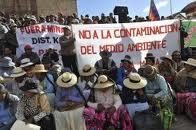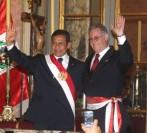As left-leaning president Ollanta Humala takes office in Peru this week, he faces the formidable challenge of resolving the country’s growing conflicts over resource extraction—the “ticking time bomb” left behind by ex-president Alan García.
Peru’s recent mining boom, spurred by a surge in global commodity prices and García’s investor-friendly policies, has fueled a decade of robust economic growth and accounts for two-thirds of the country’s export earnings. Yet 30% of the population remains impoverished, and indigenous communities adversely affected by mining--but not consulted about proposed exploitation projects--have mounted increasing resistance. The resulting social unrest, which has claimed more than 100 lives since 2008, helped to catapult Humala to his remarkable electoral victory on June 5, with 51.5% of the vote and solid backing from Peru’s indigenous and marginalized communities.
Nowhere are these tensions more evident than in the mineral-rich Puno region, where the area covered by mining concessions has tripled since 2002. Puno’s mostly indigenous population, with a regional poverty rate exceeding 60%, has experienced few benefits from mining, while paying a high cost through the contamination of their water supplies, crops, and farmlands.
This past spring, a seven-week civic strike over mining disputes in Puno paralyzed the regional economy (and, for a time, the Bolivian border crossing), and threatened to disrupt the presidential election. It ended violently with six indigenous protesters killed by police and 37 wounded at the Juliaca airport.
The mobilizations began in early May in the highlands of southern Puno, organized by the Aymará-led Natural Resources Defense Front with support from the National Federation of Communities Affected By Mining (CONACAMI). Protesters demanded that the government revoke the Santa Ana silver mining concession granted to Canada’s Bear Creek Mining Company, which they claim will pollute Lake Titicaca and nearby rivers. They also called for a halt to future extraction projects in the region.
Following a voluntary suspension of activities for the June 5 elections, and Humala’s subsequent victory, the protests resumed and spread to Puno’s northern provinces. There, a Quechua-led movement mobilized against river pollution by small-scale mine operators and construction of the massive Inambari hydroelectric dam by a Brazilian government-backed consortium. The dam threatens to displace up to 3,000 people from 70 indigenous communities.
Lame-duck president García, perhaps seeking to rehabilitate his popular image after his party’s resounding electoral defeat, surprised many by granting significant concessions to the protesters. Bear Creek’s mining license was rescinded and a three-year moratorium imposed on new mining licenses in Puno. A new policy requires mining and hydrocarbons companies in Puno to consult in advance with impacted indigenous communities, in accordance with international treaties (and a pending Peruvian law, which García had previously vetoed). Construction of the Inambari dam has been suspended.
For the most part, these concessions are temporary and have only served to punt the underlying problems to Humala. Humala has pledged to raise taxes and royalties on mining profits to fund social programs and environmental remediation in the affected communities. He also favors passage of the law requiring community consultation on all extractive projects, without veto power. “What we want to do,” he says, “is get on well with the mining companies, but we also want them to get on well with the country.”
Humala’s newly appointed mining and energy minister, Carlos Herrera, says he’ll consult with mining companies first to develop a windfall profits tax that won’t jeopardize the $42 billion in investments lined up for the next decade. Herrera is part of a new cabinet team that combines market-friendly economic managers with leftist thinkers in charge of social programs.  Their mandate from Humala is to maintain Peru’s strong economic growth while increasing social inclusion.
Their mandate from Humala is to maintain Peru’s strong economic growth while increasing social inclusion.
At least some mining transnationals have given a vote of confidence to Humala’s proposed approach. This past week, the Peruvian/ US conglomerate owner of the Conga gold and copper mine authorized Peru’s largest single mining investment ($4.8 billion).
Whether the new mining policies that emerge from Humala’s government will satisfy the popular movements that shut down Puno last spring remains to be seen. Expectations for Humala run high in Puno, where he received an overwhelming 78% of the vote, the highest of any region in the country.
Walter Aduviri, leader of the Natural Resources Defense Front, wants to know what Humala plans to do about the 600 mining applications that are currently pending in Puno, and has given the government 30 days to pass the new consultation law. Opponents of the Inambari dam want the project permanently cancelled, and worry that Humala’s close ties to Brazil might prevent this outcome.
Meanwhile, Bear Creek has filed for an injunction to regain its mining license, and is considering further legal action against the Peruvian government under the Canada-Peru Free Trade Agreement. How Humala chooses to balance these investment and economic pressures with the demands of a growing anti-mining movement, in Puno and elsewhere, could be the defining challenge of his administration.

